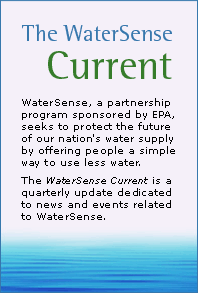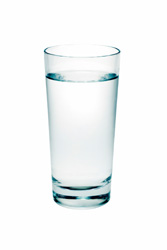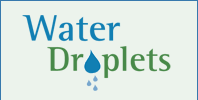The WaterSense Current Fall 2009
In This Issue XII, Fall 2009:
 |
In This Issue: |
The Big Apple Is Looking to Save Big

New York City residents use 1.1 billion gallons of water every single
day—enough to fill the Empire State Building with water five
times! That's a lot of water, and a lot of potential water
savings now that the New
York City Department of Environmental Protection (NYC DEP)![]() has joined EPA's WaterSense program.
has joined EPA's WaterSense program.
According to NYC DEP's Mercedes Padilla, leaking toilets and running faucets are among the greatest water-efficiency challenges in New York City. “The city benefits when people use WaterSense labeled toilets and lavatory sinks because they use less water and perform better,” she says. “Conserving this precious resource will not only help New Yorkers save money, but it helps to conserve the supply we all depend on.”
As a promotional partner, NYC DEP will help EPA educate consumers
about the value of water, water efficiency, and the WaterSense label.
WaterSense already made its Broadway debut in 2007 and 2008 with
the Charmin
Holiday Restrooms![]() in Times Square. The restrooms featured WaterSense labeled Kohler
brand toilets and faucets and spelled relief for both tourists and
locals in need of a public restroom during the holiday shopping
season and on New Year's Eve.
in Times Square. The restrooms featured WaterSense labeled Kohler
brand toilets and faucets and spelled relief for both tourists and
locals in need of a public restroom during the holiday shopping
season and on New Year's Eve.
Since joining the program early this year, NYC DEP has already begun spreading the news about WaterSense to its approximately 9 million customers through its Web site and at public outreach events. Thanks to this partnership and the prospect of better water efficiency, the Big Apple could earn a new nickname: the city that never leaks.
What Is Your Water Worth?

Believe it or not, water is undervalued in many parts of the country. In fact, about 30 percent of all water utilities operate at a loss or a deficit. So where does all your money go? The money you pay toward your water bill is stretched many different ways by utilities.
Water utilities, like any business, need to pay for operating expenses such as electricity, treatment chemicals, maintenance, and employee wages. On average, about 70 percent of your water bill goes to your water utility's operating expenses.
As they work to collect sufficient revenue to ensure the availability of clean and safe water, municipalities and water managers try to keep their rates affordable. Even so, the cost of water and wastewater varies, and the factors that ultimately set the price differ from community to community. Many private water utilities serving smaller communities lack commercial and industrial customers that help keep costs to residents low. These utilities are sometimes forced to charge residents nearly double the national average to recoup operating expenses. In these communities, investing in water efficiency makes twice as much sense.
But that only makes up part of your water utility's financial needs. Many water utilities need money to pay for improvement projects to upgrade infrastructure or increase capacity—meaning the ability to provide water to an expanding number of customers—and they might also need to pay down debt just like the rest of us. In fact, EPA studies estimate that updating aging water and wastewater infrastructure could cost more than $500 billion over the next two decades. While many of the pipes that deliver water to American homes are relatively new, some pipes are more than 80 years old and well overdue for replacement. And this $500 billion does not include the funds that are needed to build new infrastructure to meet the demands of a growing population!
The good news is that there is something both utilities and consumers can do to delay these major investments and save money. WaterSense makes fiscal sense, both from a utility standpoint, and to consumers' wallets. Many water utilities are promoting WaterSense labeled products to help their customers save on water bills and to delay the utilities' need for expensive projects to increase capacity.
So if you're looking for new ways to pinch pennies as a household,
consider the following.
The average household can reduce its water bills by as much as 30
percent by installing water-efficient plumbing fixtures such as
WaterSense labeled toilets and faucets and ENERGY STAR qualified
appliances. Replacing older, inefficient toilets alone could save
a family of four some $90 per year. These savings, coupled with
potential rebates in your area,
mean your bathroom makeover could pay for itself in no time—and
pay the savings forward in your community for years to come.
WaterSense to Label First Commercial Product


With the recently finalized WaterSense specification for flushing urinals, you will soon see WaterSense labeled products in commercial and institutional restrooms.
WaterSense labeled urinals have the potential to help save businesses and institutions water and money on utility bills. If all urinals installed before 1994 were replaced with WaterSense labeled models, it would save nearly 36 billion gallons of water annually—equal to the flow over Niagara Falls in 20 hours.
To earn the WaterSense label, urinals must flush using no more than half a gallon, well below the current federal standard of 1.0 gallon per flush (gpf). Older models installed before regulations were in place can use even more water—as much as 5.0 gpf. As with all WaterSense labeled products, urinals must undergo independent, third-party testing and certification before earning the WaterSense label.
Schools, restaurants, businesses, and other commercial buildings can benefit from the financial savings of WaterSense labeled urinals. If a high school of 1,000 students replaced its inefficient urinals, for example, it could save enough to supply water for nearly 700 households.
EPA estimates that there are about 12 million urinals currently in use in the United States, and up to 65 percent of them are inefficient models that use significantly more than the federal standard. For every inefficient urinal replaced with a WaterSense labeled model, 4,600 gallons are saved annually. Learn more about the WaterSense specification for flushing urinals.
Partner Profile: 2009 WaterSense Partners of the Year
It's that time of year again. Time to toast the WaterSense partners who have made extraordinary efforts to advance the WaterSense program. This year's winners show how working together can help customers and communities of all sizes save water.
Manufacturer Partner
Kohler Co. continued to demonstrate its commitment to water efficiency
by winning its second WaterSense Partner of the Year award in a
row. The manufacturer supported regional incentives and initiatives
for water efficiency from Atlanta to Denver with its “mobile
restrooms,” trailers fully equipped with Kohler toilets and
faucets that have earned the WaterSense label. In addition to publicizing
WaterSense on the road, in the tradeshow circuit, on reality television,
and in the restrooms of New York City's Rock 'n'
Roll Hall of Fame Annex, Kohler gave WaterSense a national spotlight
through Save Water America![]() ,
a Web site dedicated to educating homeowners about water efficiency
and supporting Habitat for Humanity with a $1 million product donation.
,
a Web site dedicated to educating homeowners about water efficiency
and supporting Habitat for Humanity with a $1 million product donation.
Retailer/Distributor Partner

Throughout its 1,650 home improvement stores, Lowe's
Companies, Inc. emphasized the nexus between saving water
and saving energy to its customers. From launching an “Efficient
Home” Web site![]() to distributing a bilingual Efficient Home Guide, Lowe's has
highlighted WaterSense inside its stores and in its stores'
communities. Likewise, Lowe's has continued to educate its
more than 215,000 employees on how to identify WaterSense labeled
products and explain their benefits, capitalizing on training tools
such as Lowe's internal video channel and companywide marketing
meetings. All this training happened just in time for the sales
tax holidays in Georgia and Virginia. During these events, shoppers
received a special discount for various WaterSense labeled products
that Lowe's helped negotiate with Kohler, American Standard,
and Jacuzzi.
to distributing a bilingual Efficient Home Guide, Lowe's has
highlighted WaterSense inside its stores and in its stores'
communities. Likewise, Lowe's has continued to educate its
more than 215,000 employees on how to identify WaterSense labeled
products and explain their benefits, capitalizing on training tools
such as Lowe's internal video channel and companywide marketing
meetings. All this training happened just in time for the sales
tax holidays in Georgia and Virginia. During these events, shoppers
received a special discount for various WaterSense labeled products
that Lowe's helped negotiate with Kohler, American Standard,
and Jacuzzi.
Promotional Partner – Large Utility

In 2007 and 2008, the Southeast region's worst drought in 150 years prompted Cobb County Water System to promote WaterSense and water efficiency to its 650,000 residents in the Atlanta, Georgia metropolitan area. Cobb County implemented a toilet rebate program that discounted 1,650 WaterSense labeled toilets, inspiring other large utilities in the Metro North Georgia Water Planning District to adopt the county's rebate model. And because everyone loves a good deal, Cobb County collaborated with other WaterSense retailer, manufacturer, and promotional partners (including fellow winners Kohler and Lowe's) to promote the Georgia statewide sales tax holiday weekend in October 2008 for WaterSense labeled and ENERGY STAR qualified products. Coordinating closely with these organizations, Cobb County ensured that rebates were also widely promoted and that labeled products were stocked on retailers' shelves. The results speak for themselves: during the sales tax holiday Cobb County saw a 400 percent increase in WaterSense labeled toilet purchases over any comparable timeframe!
Promotional Partner – Small Utility

James City Service Authority's (JCSA's) exceptional rebate program propelled this small water utility to the top of the list. Serving approximately 46,000 people in southeastern Virginia, JCSA offers rebates for one of the widest varieties of products in the Southeast, ranging from WaterSense labeled toilets to rain sensors, and rain barrels to “on demand” hot water recirculators. JCSA also offers a $500 rebate for customers hiring a WaterSense irrigation partner to design, install, or audit a water-efficient irrigation system. To further educate its customers about outdoor water efficiency, JCSA has established its own “Let's Be Water Smart” program, a joint effort by 35 builders, developers, contractors, irrigation specialists, landscape designers, and landscapers working together to rein in outdoor water use.
Irrigation Partner

As president of Irrigation Consulting, Inc., in Pepperell, Massachusetts, not only does Brian Vinchesi require his company's staff to complete at least one WaterSense labeled certification program, he leads by example, having completed four such certifications himself. Beyond his consulting business, Mr. Vinchesi has shared his water-efficient irrigation expertise by teaching for the last 25 years, currently chairing the Irrigation Association Education Foundation. In 2008, he lectured at six conferences and symposia and taught nearly a dozen classes focused on water efficiency and sustainable irrigation systems, helping to spread the word about WaterSense from coast to coast. Working to coordinate efforts among a coalition of water purveyors, equipment manufacturers, and irrigation professionals, Mr. Vinchesi also has headed up the Irrigation Association's Smart Water Application Technologies (SWAT) initiative since its inception in 2001.
Learn more about the 2009 WaterSense Partners of the Year.
Fixing Leaks Can Be Elementary, My Dear Watson
Learning about water efficiency can be as easy as 1-2-3 with WaterSense's recently released Fix a Leak Week curriculum. WaterSense has developed lessons for grades 3 through 5 that focus on saving water through finding leaks. Nationwide more than 1 trillion gallons of water leak from U.S. homes each year. In fact, the average home can waste 11,000 gallons of water per year, enough to fill a backyard swimming pool. But students can learn about saving water and conduct fun science experiments by sleuthing out leaks where they live and helping parents find ways to fix them. The free resources offer step-by-step instructions for teachers and include ready-made worksheets for students. Parents and water conservation outreach coordinators may also find these materials and a corresponding family pledge to save water useful. While the curriculum is designed to be taught during Fix a Leak Week (March 15–21, 2010), the concepts are timeless and worthy of teaching any time of the year. Learn more about Fix a Leak Week 2010 and the teacher's curriculum. |
 |
 |




